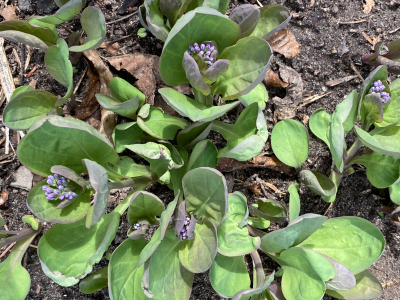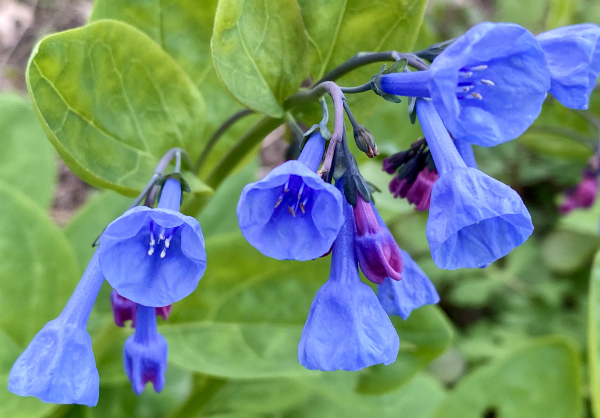VIRGINIA BLUEBELLS, Mertensia virginica
By Joyce Tuharsky
Nothing signifies the arrival of spring more than the enchanting display of Virginia bluebells gracing a clearing within a moist woodland or along a riverbank.
The flowers of this spring ephemeral start out as nodding pink buds that open into pendulant, trumpet-like, lavender-blue blooms–each about one inch long. Slightly fragrant, these blooms provide an important source of early season food for pollinators. Bees are often seen visiting the flowers; but only the largest bees, such as long-tongued bumblebees, can push their way up the trumpet-like tube. Other pollinators include butterflies, skippers, flower flies, hummingbirds, and hummingbird moths.

Virginia bluebell blooms last about 3 weeks in early to mid-spring. As summer approaches, the flowers close, looking like deflated pink balloons. Each fertilized flower produces a 4-lobed structure known as “schizocarp” which contains four nutlets per flower.
The plant itself is erect, clump-forming, with branched arching stems that grow 1–2 feet tall. The oval, smooth leaves (2 to 8 inches long) emerge purple in color, but soon turn a lovely blue-green. In mid-summer, the foliage dies back; and the plant goes dormant. Rhizomes persist underground, storing nutrients and water until the next spring.
Virginia bluebells are native to cool, shady woodlands and floodplains throughout most of eastern North America (from Minnesota/Arkansas east); but unfortunately, they are sparse in much of its range due to habitat loss. Listed as threatened in Michigan, Virginia bluebells have been found within the Grand, Raisin, and St. Joseph River systems. Other common names for this plant include “Eastern bluebells” and “Virginia cowslip.”
Virginia bluebells are easy to care for once established, adding a touch of class to any garden. They prefer nutrient-rich, moist but well-drained soil (neutral pH), located in dappled shade. They are perhaps best naturalized in a cool woodland where they will form large colonies over time. Virginia bluebells may also be sprinkled in shady borders or corners of a garden; but since the plants go dormant in summer, consider overplanting with other perennials. Good companion plants include Solomon’s seal, ferns, and trilliums.
Virginia bluebells may be propagated by seed or rhizome division. Divide rhizomes while the plant is dormant. Water regularly and provide compost for young plants until they are well-established. These plants usually do not bloom until the 2nd or 3rd year after planting or transplanting. They are deer and rabbit resistant, tolerate Black walnut, and have no serious insect or disease problems aside from a few snails/slugs. Virginia bluebells are considered a long-lived perennial; but it is hard to know, since they are efficient self-seeders—individual plants may live about 5 years.

For More Information:
“How to Grow and Care for Virginia Bluebells” (thespruce.com), 3/12/23.
“Virginia Bluebells—A Complete Guide to Mertensia virginica” (GrowIt BuildIT)
“How To Grow And Care For Virginia Bluebells” (southernliving.com), 2/15/23. /
